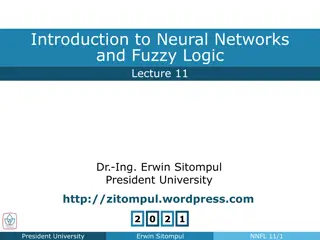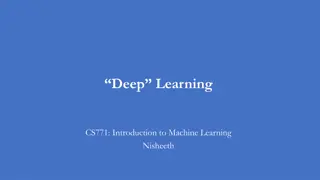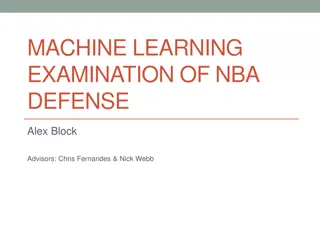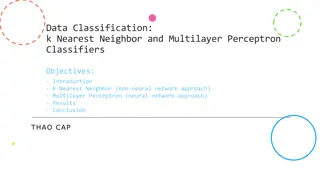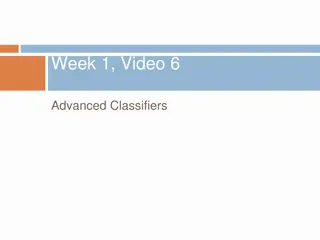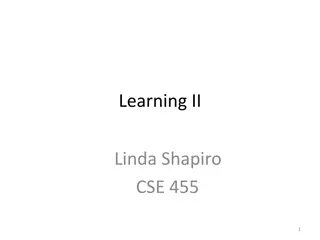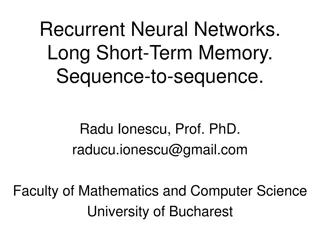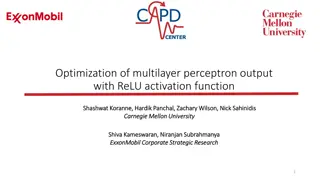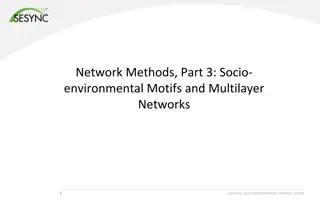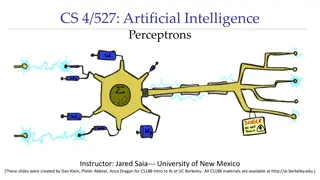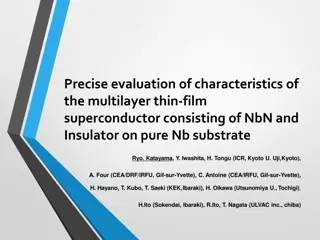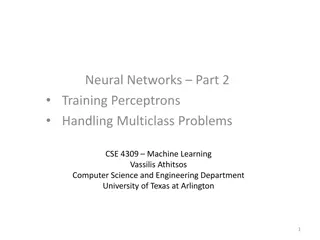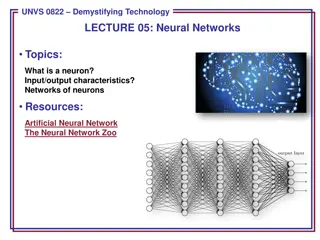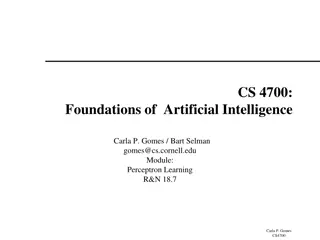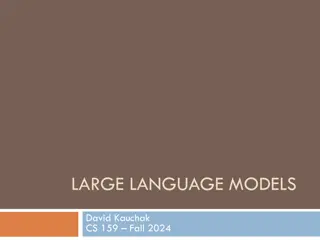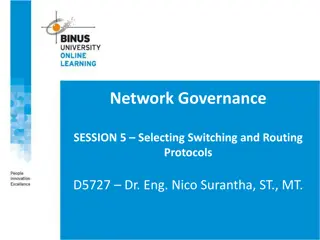Introduction to Deep Learning: Neural Networks and Multilayer Perceptrons
Explore the fundamentals of neural networks, including artificial neurons and activation functions, in the context of deep learning. Learn about multilayer perceptrons and their role in forming decision regions for classification tasks. Understand forward propagation and backpropagation as essential
4 views • 74 slides
Artificial Neural Networks From Scratch
Learn how to build artificial neural networks from scratch, focusing on multi-level feedforward networks like multi-level perceptrons. Discover how neural networks function, including training large networks in parallel and distributed systems, and grasp concepts such as learning non-linear function
3 views • 33 slides
Multi-Layer Perceptrons in Neural Networks
In this lecture by Dr. Erwin Sitompul at President University, the focus is on Multi-Layer Perceptrons (MLP) in neural networks, discussing their architecture, design considerations, advantages, learning algorithms, and training process. MLPs with hidden layers and sigmoid activation functions enabl
2 views • 17 slides
Limitations and Advancements in Machine Learning
Unveil the limitations of linear and classic non-linear models in machine learning, showcasing the emergence of neural networks like Multi-layer Perceptrons (MLPs) as powerful tools to tackle non-linear functions and decision boundaries efficiently. Discover the essence of neural networks and their
1 views • 16 slides
NBA Defense Evaluation Using Machine Learning
Explore the attributes influencing NBA defensive effectiveness through a machine learning examination conducted by Alex Block Advisors, Chris Fernandes, and Nick Webb. The study analyzes various factors such as shooting percentage, turnovers, offensive rebounding, and free throws. Data from the 1996
1 views • 25 slides
Data Classification: K-Nearest Neighbor and Multilayer Perceptron Classifiers
This study explores the use of K-Nearest Neighbor (KNN) and Multilayer Perceptron (MLP) classifiers for data classification. The KNN algorithm estimates data point membership based on nearest neighbors, while MLP is a feedforward neural network with hidden layers. Parameter tuning and results analys
0 views • 9 slides
Advanced Classifiers and Neural Networks
This content explores the concept of advanced classifiers like Neural Networks which compose complex relationships through combining perceptrons. It delves into the workings of the classic perceptron and how modern neural networks use more complex decision functions. The visuals provided offer a cle
2 views • 26 slides
Advanced Microscopy Techniques in EUV Lithography: SHARP Overview
SHARP utilizes Fresnel zone plate lenses to achieve diffraction-limited quality in EUV lithography, offering a range of NA values and image magnifications. The system allows emulation of mask-side imaging conditions with hundreds of lenses available. Coherence control and engineering are provided th
2 views • 18 slides
Neural Network Learning and Perceptrons
Explore the world of neural network learning, including topics like support vector machines, unsupervised learning, and the use of feed-forward perceptrons. Dive into the concepts of gradient descent and how it helps in minimizing errors in neural networks. Visualize the process through graphical ex
2 views • 54 slides
Recurrent Neural Networks: Fundamentals and Applications
Explore the realm of Recurrent Neural Networks (RNNs), including Long Short-Term Memory (LSTM) models and sequence-to-sequence architectures. Delve into backpropagation through time, vanishing/exploding gradients, and the importance of modeling sequences for various applications. Discover why RNNs o
0 views • 102 slides
Optimization of Multilayer Perceptron Output with ReLU Activation Function Using MIP Approach
This research focuses on developing a systematic optimization model that incorporates a ReLU activation function-based neural network as input. The model generates a linear output that can be modeled as MILP and solved using a Mixed-Integer Programming approach. By producing scalable surrogate model
1 views • 7 slides
Kernels and Perceptrons: A Comprehensive Overview
Kernels and Perceptrons are fundamental concepts in machine learning. This overview covers the Perceptron algorithm, Kernel Perceptron, and Common Kernels, along with Duality and Computational properties. It also explores mapping to Hilbert space and the computational approaches for achieving desire
3 views • 40 slides
Socio-Environmental Motifs and Multilayer Networks
The content delves into socio-environmental motifs, anti-motifs, and multi-plex networks in the context of national socio-environmental synthesis centers. It uncovers the least likely and common occurrences in random networks, as well as common subnetworks underrepresented in the model of inquiry. T
0 views • 7 slides
Neural Networks – Part 2
The training process of perceptrons in handling multiclass problems, understand the notation for training sets, and optimize model parameters for single perceptrons. Learn how perceptrons serve as regression models and binary classifiers in neural networks.
0 views • 45 slides
Introduction to Perceptrons and Neurons in Neural Networks
This content provides an overview of perceptrons, their functionality in mapping D-dimensional vectors, and how they are inspired by neurons in the brain. It covers the computation process of perceptrons, including bias weight notation, activation functions, and the significance of different choices
0 views • 45 slides
Artificial Intelligence Perceptrons: Linear Classifiers and Geometric Explanation
In these slides, explore the concept of artificial intelligence perceptrons including linear classifiers, feature vectors, and geometric explanations. Learn about weight updates and the learning process of binary perceptrons. Understand how weights are adjusted based on training instances and delve
0 views • 24 slides
Introduction to Neuroevolution and Neural Networks
Neuroevolution involves evolutionary algorithms to tune neural network parameters, while neural networks have evolved from perceptrons to multi-layer perceptrons. This overview covers neuroevolution techniques, comparison with deep learning, and historical background.
0 views • 32 slides
Neural Networks for Handwritten Digit Recognition
In this chapter, we delve into implementing a neural network that can recognize handwritten digits efficiently without the need for human intervention. The neural network learns from a large set of training examples and infers rules to enhance its accuracy. We explore the working of perceptrons, the
0 views • 47 slides
Understanding Neural Networks and Neuron Models
Explore the fascinating world of neural networks, from biological neural activity to artificial neural networks and neuron models. Learn about the structure, connectivity, and functions of neurons, as well as the basics of perceptrons and simple architectures. Discover how neural networks can be app
0 views • 19 slides
Precise Evaluation of Characteristics of Multilayer Thin-Film Superconductor
Explore the precise evaluation of characteristics of a multilayer thin-film superconductor consisting of NbN and insulator on a pure Nb substrate. The study focuses on improving the effective Hc1 to enhance the maximum accelerating gradient of superconducting cavities. Experimental results show a 17
0 views • 10 slides
Training Perceptrons for Multiclass Problems in Neural Networks
Understanding the training process of perceptrons for multiclass problems in neural networks. Exploring the notation for training sets, error functions, and the application of gradient descent in learning. Unveiling strategies for handling single perceptron learning and optimizing using the sigmoid
0 views • 34 slides
Understanding Neural Networks: Neurons, Perceptrons, and Sigmoid Neurons
Delve into the fundamentals of neural networks including neurons, perceptrons, and sigmoid neurons. Explore how these components function and interact in artificial intelligence systems for various applications.
1 views • 8 slides
Understanding Perceptron Learning for Artificial Intelligence
Learn about the derivation and application of a learning rule for perceptrons to minimize squared errors, including the gradient descent algorithm and the intuition behind perceptron learning. Discover how perceptron learning works through weight space and its convergence properties.
0 views • 9 slides
Neural Network Fundamentals and Activation Functions Overview
Explore the basics of neural networks, including single neurons, perceptrons, and recurrent neural networks. Learn about activation functions like hard threshold, sigmoid, and softmax. Understand how neural networks process inputs and compute answers through layers, leading to the final output. Dive
0 views • 59 slides
Solving Data Classification Challenges with Support Vector Machines
Explore the limitations of perceptrons in classifying non-linearly separable data and how Support Vector Machines offer a solution through effective algorithms. Learn about transforming data spaces, avoiding overfitting, and addressing the issue of multiple hyperplanes in classification tasks.
0 views • 57 slides
Understanding Neural Networks and Activation Functions
Explore the concepts of modeling, neural networks, and activation functions in this comprehensive guide. Learn about multilayer perceptrons, continuous activation functions, and more to enhance your understanding of artificial intelligence and machine learning algorithms.
0 views • 29 slides
Implementing Neural Network Models using Tensorflow
Dive into the fundamentals of deep learning and Tensorflow programming in this course. Learn how to implement basic Neural Network models using Tensorflow in Python. Discover what neural networks are, delve into multi-layer perceptrons, understand parameter learning with loss functions, and explore
1 views • 8 slides
Selecting Switching and Routing Protocols in Network Governance Session 5
Learn about the criteria for selecting switching and routing protocols, including transparent bridging, VLAN technologies, and multilayer switching. Explore decision-making processes and examples of decision tables in the context of network governance at Bina Nusantara University.
0 views • 36 slides
Molecular Genetics and Machine Learning in AI for Medicine
Explore the intersection of molecular genetics and machine learning in the context of AI for Medicine. Learn about the limitations of consensus sequences and the role of perceptrons in DNA and RNA sequence analysis. Discover how perceptrons work in classifying genetic data based on linear separabili
0 views • 34 slides
Particle Accelerator Control System Architecture Overview
Learn about the multilayer architecture of modern particle accelerator control systems, including the presentation layer, application layer, and resource layer. Explore how low-level drivers and virtual objects are used to connect and manage devices in such systems.
0 views • 18 slides
Understanding Backpropagation in Adaptive Networks
Learn about backpropagation (BP) in adaptive networks, a systematic way to compute gradients, reinvented in 1986 for multilayer perceptrons (MLP), and its applications in two-layer and three-layer adaptive networks.
0 views • 14 slides


